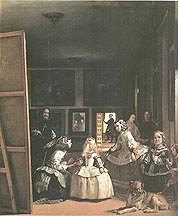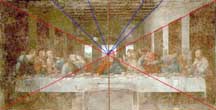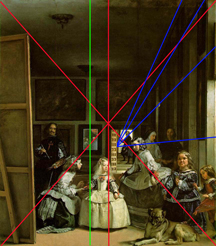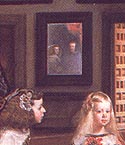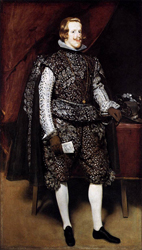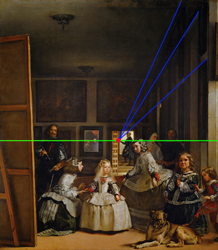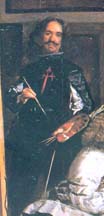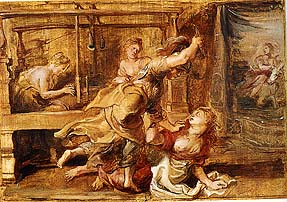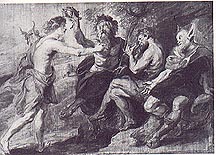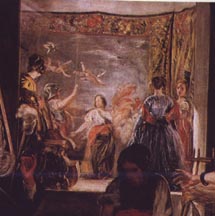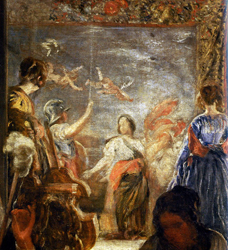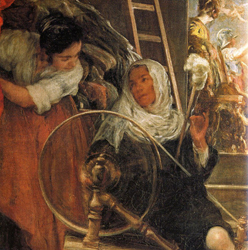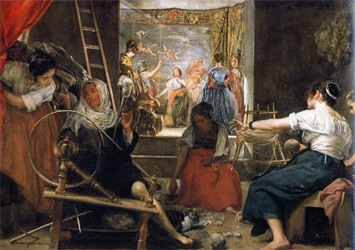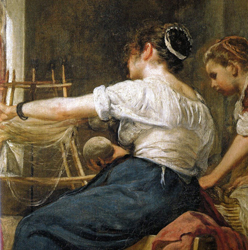ARTH Courses | ARTH 200 Assignments
Velázquez's Las Meninas
Velázquez's Las Meninas has long captivated viewers by its effect of naturalism. Nineteenth century critics saw it as anticipating the invention of the camera with its effect of capturing a "snapshot" of a moment in time and space. Contemporary critics have emphasized the calculated control Velázquez employed to construct this effect of naturalism. Rather than as a snap-shot, a transparent window, or a spotless mirror of the world, Las Meninas is today seen to be more about the nature of painting, the artist's control over representation, and the status of Velázquez as a court artist.
The control
of Velázquez can perhaps be best seen in the effect of spontaneity
and relative informality of the foreground group. 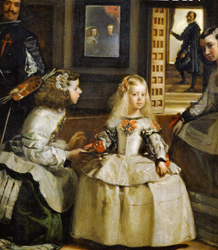 The
Infanta Margarita, the daughter of the King and Queen of Spain, is made the
most central figure in the foreground group by placing her the closest to
the center axis of the painting but very intentionally not on that axis. She
is placed just to the left of center. At the same time the light streaming
in from the window on the right falls on her more than the surrounding figures.
The poses of the figures around her with their gestures call attention to
their defference to her authority at the same time as acknowledging the presence
of the viewer. Seven of the nine figures stare outward. The effect of this,
rather than breaking the spell of spontaneity, implicates the viewer into
the narrative of the painting. We are made to be as much a part of the composition
as any of the other figures in the painting. We take on the role of both the
observer and the observed. There is a reciprocity between our looking and
that of the characters in the painting. Without our presence, their glances
do not make sense. The role we play in this story is revealed by the mirror
image just over the Infanta's right shoulder. Our role as the King or Queen
of Spain explains the attention paid to our presence by the other figures.
The relationship of the Infanta to the royal couple is visually asserted by
Velázquez by positioning her closest to the mirror image on the picture
plane.
The
Infanta Margarita, the daughter of the King and Queen of Spain, is made the
most central figure in the foreground group by placing her the closest to
the center axis of the painting but very intentionally not on that axis. She
is placed just to the left of center. At the same time the light streaming
in from the window on the right falls on her more than the surrounding figures.
The poses of the figures around her with their gestures call attention to
their defference to her authority at the same time as acknowledging the presence
of the viewer. Seven of the nine figures stare outward. The effect of this,
rather than breaking the spell of spontaneity, implicates the viewer into
the narrative of the painting. We are made to be as much a part of the composition
as any of the other figures in the painting. We take on the role of both the
observer and the observed. There is a reciprocity between our looking and
that of the characters in the painting. Without our presence, their glances
do not make sense. The role we play in this story is revealed by the mirror
image just over the Infanta's right shoulder. Our role as the King or Queen
of Spain explains the attention paid to our presence by the other figures.
The relationship of the Infanta to the royal couple is visually asserted by
Velázquez by positioning her closest to the mirror image on the picture
plane.
A comparison of Las Meninas to a work like Leonardo's Last Supper is instructive. In the two diagrams above the green lines define the central axis of the back walls of the rooms depicted in the paintings. The red diagonal lines define the center of the paintings, and the vertical red lines articulate the central axes of the paintings. The blue lines articulate the orthogonals in the perspective systems. As is well known all of these converge in the case of Leonardo's painting on the head of Christ. In the Velázquez none of these line up. Imagine how the spontaneity and air of informality of the painting would have been lost if Velázquez had centered the head of the Infanta in the middle of the mirror in the background, had the orthogonals converge on her head, and had her head appear on a line that marked both the central axis of the painting and the center of the back wall of the room. In the Leonardo we are a detached observer taking the ideal point of view. All the meaning of the work is intelligible from this single point of view. There is no role for us to play within the narrative of the Last Supper. In Las Meninas there is no ideal point of view, but we are implicated in the painting. As noted above we take on the role of the King and Queen of Spain.
The mirror on the back wall with its reflected images of the king and queen asserts the artist's control over the illusion. Clearly the mirror does not reflect what is directly in front of it. We do not see the back of Velázquez or any of the other figures in the foreground of the composition. The size of the reflection of the king and queen and the perfect cropping of the royal couple in the frame of the mirror are not consistent with our position standing before the image. The position of the vanishing point of the perspective system in relationship to the mirror indicates another inconsistency. If the viewer is intended to take on the literal point of view of the King and Queen, the vanishing point would have to be directly in the center of the mirror, but it is positioned to the right of the mirror. From that point of view the reflection would not be of the King and Queen, but it would be more likely the reflection of the image of the King and Queen in the painting Velázquez works on. Is this intentional on Velázquez's part to leave the viewer with the question of whether the mirror reflects the King and Queen or their image? Or in other words in looking at the reflection in the mirror are we looking at the reflection of art or nature?
The positioning of the vanishing point (red dot) indicates that the horizon line (green line) of the perspective system would be consistent with the reflected image of the King and Queen. This clearly places the constructed viewer below the figure of Velázquez standing at his easel. This lower point of view is also indicated by the positioning of the standing figures of Doña Marcela and the guardadamas lower on the picture plane than the figure of Velázquez. If Velázquez had designed the painting to create the illusion of the King and Queen standing in the space of the represented chamber the horizon line would need to have been higher on the picture plane, and the heads of the standing figures would appear along this common horizon line. A possible explanation would be that Velázquez would have been aware that the bottom of the painting could not have been placed at the level of the floor of the room housing Las Meninas, but that the painting was designed to be hung so that the bottom of the frame was slightly up the wall. By placing the horizon line lower on the picture plane than the standing figures in the painting, Velázquez was adjusting for this inconsistency and creating the illusion that the horizon line of the painting is consistent with the actual eye-level of the King standing in front of the painting in the pieza del despacho. Velázquez's spatial construction also has probably the intentional consequence of making himself, the artist, as the highest figure in the painting.
What explains the "naturalism" of the painting with its effect of spontaneity and relative informality? It will be argued here that the painting's "naturalism" needs to be understood in the context of Velázquez's identity as a court painter and member of the court of Philip IV. Las Meninas can be connected to a tradition of images of princes and the structure of European courts that goes back at least to the fourteenth century court of Charles V of France. A Bible historiale made for Charles V has a famous frontispiece showing Jean Vaudetar presenting the book to Charles V.
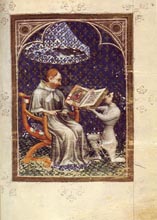 |
I have argued elsewhere that the innovative aspects of this miniature including the attention to the individualized portraits of Charles V and Vaudetar and the emphasis on the illusion of space can be related to the period's greater emphasis placed on the differentiation between the public and private worlds of the king. During the fourteenth century palace design distinguished between the more public world of the grand hall and the more private world of the king's chamber. The chamber itself became divided up to distinguish between the space of the presence chamber where the monarch could greet foreign ambassadors and the king's bedchamber which was accessible to only the highest members of the court. By the sixteenth century, the process continued with the creation of an inner sanctum within the chamber, the privy chamber. In the world of the court your relative importance was directly reflected by which chamber you were appointed to. The higher one was in the court hierarchy the more intimate one would be to private world of the monarch. The relative informality of the king's dress and the close spatial relationship between Vaudetar and Charles V is likely a reflection of the King's chamber as the center of the politics and patronage of the court. The relationship between the prince and his court was a personal one and not an institutional one. The king could appoint and dismiss at his own pleasure. On the death of the monarch, the court would be disbanded. Power at court was judged by the degree of intimacy the courtier had with the king. While this miniature is today one of the most famous monuments of fourteenth century French manuscript illumination, the book it comes from one was designed for the personal use of Charles V. The Bible manuscript was intended for the private library of Charles V adjacent to his personal chambers in the newly re-designed Louvre. It is signiificant as documented by the facing dedicatory inscription that this miniature was done by "iohannes de Brugis pictor regis"
Velázquez represents himself standing at his easel. He holds in his left hand his palette and a brush in his right. In his belt is the key to the King's chamber. According to Palomino, Philip IV had given Velázquez a key to his chamber, a much sought after privilege by the members of the nobility at court. On his blouse appears the red cross of the Order of Santiago. Palomino says this was added after Velázquez's death by order of Philip IV if not as tradition has it by the king himself. He is thus represented with the trappings of his position as court artist. Accounts of Velázquez's life emphasize the close relationship between the artist and Philip IV. This includes the account of Pacheco, Velázquez's father-in-law, who observed that Velázquez was treated with "incredible liberality and affability by this great monarch, who continually visited him almost every day to see him paint in the workshop that he had in the King's gallery." Pacheco records that the king even had a key to Velázquez's studio. Palomino elaborates on the historical context of this relationship between monarch and artist by observing "as Alexander did with Apelles, often going to see him paint, honoring him with such singular favor, as Pliny tells in his Natural History (lib. 31, cap. 10), and as Charles V with Titian...." Philip IV honored his painter's position at court by appointing Velázquez to a succession of increasingly important court posts. He was first appointed to the office of Ayuda de la Guardarropa. In 1643, Velázquez was appointed to the position of Ayuda de Cámara in 1643. In 1653 Velázquez was appointed Apostentador Mayor, a position at the pinnacle of the palace hierarchy. The sequence of offices held by Velázquez brought him in increasingly intimate contact with the king.
In 1666, the year after the death of Philip IV, Las Meninas is listed in the so-called pieza del despacho, a room in the Alcázar in Madrid that was designed for the personal use of the king. It was thus a painting not designed for public display like its large size might suggest, but intended for the private use of the king. Today Las Meninas easily ranks among the most famous works of Western Art, but its location in the Alcázar indicates that only a very few people would be allowed to see it.
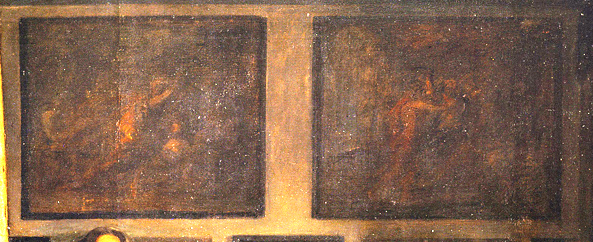 |
|
Las Meninas takes place in the Pieza Principal, the chambers previously occupied by Prince Baltasar Carlos. Velázquez was granted these chambers after the death of the Prince as a token of the privileged position of Velázquez at the court of Spain. Palomino
in his account of Las Meninas identifies the paintings on the walls
as stories from Ovid's Metamorphoses by Rubens. The two large
paintings have been related to oil sketches by Rubens. The one on the
left is Minerva Punishing Arachne, while the one on the right is Apollo's
Victory over Marsyas. The paintings were not the originals by Rubens, but were copies done by Velázquez's son-in-law and assistant, Juan Bautista del Mazo. Both Ovidian subjects deal with the themes of the
divine source of the arts and  human rivalry with the Gods. In the Minerva Punishing Arachne, Rubens includes a reference to Titian's Rape of Europa in the tapestry on the right hand side of the painting.
human rivalry with the Gods. In the Minerva Punishing Arachne, Rubens includes a reference to Titian's Rape of Europa in the tapestry on the right hand side of the painting.  Rubens had copied the Titian painting which was in the Spanish king's collection. Velázquez by including the Rubens's Minerva Punishing Arachne is linking himself to Rubens as the most celebrated court artist of his period and to Titian who had been the favorite court painter of the Emperor Charles V, the great grandfather of Philip IV. Velázquez will return to the story of Minerva punishing Arachne and to the Titian Rape of Europa in the background of The Spinners.
Rubens had copied the Titian painting which was in the Spanish king's collection. Velázquez by including the Rubens's Minerva Punishing Arachne is linking himself to Rubens as the most celebrated court artist of his period and to Titian who had been the favorite court painter of the Emperor Charles V, the great grandfather of Philip IV. Velázquez will return to the story of Minerva punishing Arachne and to the Titian Rape of Europa in the background of The Spinners.
Velázquez, The Spinners, c. 1658.
